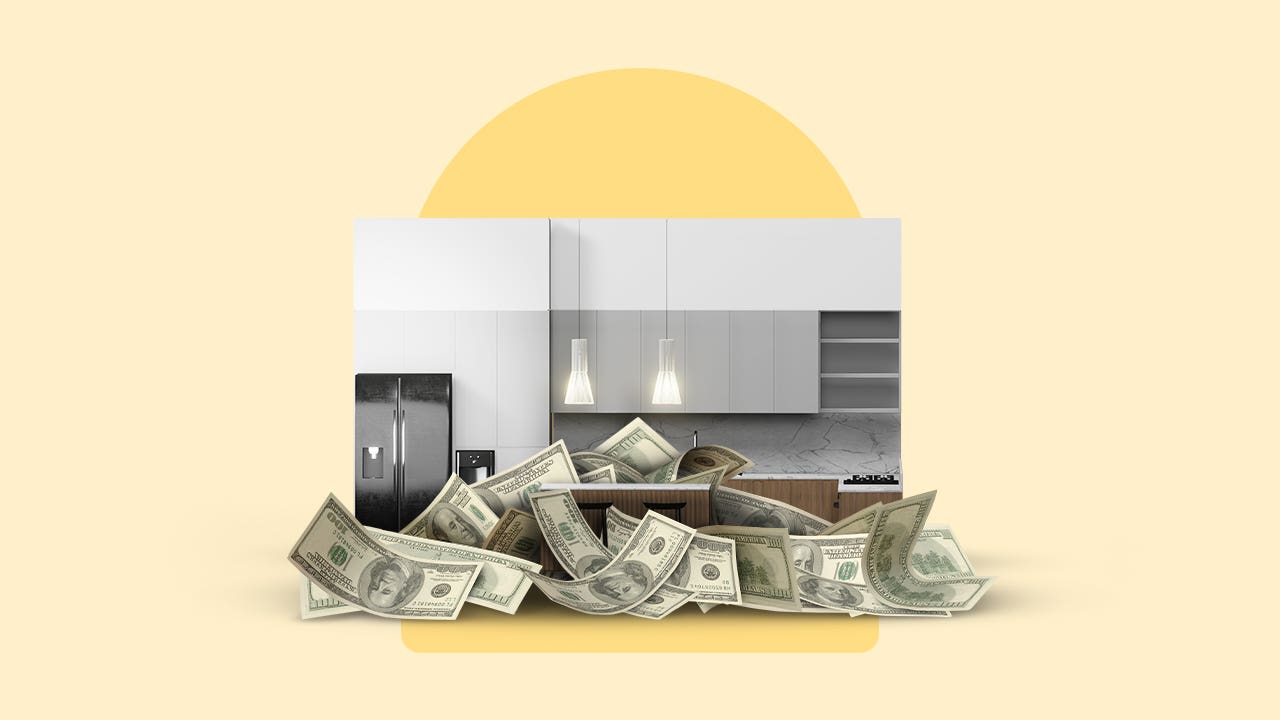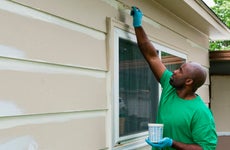The top renovations that increase home value in 2024

The Bankrate promise
At Bankrate we strive to help you make smarter financial decisions. While we adhere to strict , this post may contain references to products from our partners. Here's an explanation for .
2024 might not be the easiest time to buy a new home, but that doesn’t mean you can’t invest in your property. With home prices at historic highs, many aspiring homeowners are willing to buy a place that needs substantial work if it’s the only way to make a purchase happen. Meanwhile, elevated mortgage rates are causing many current homeowners to not buy, but to stay put and upgrade their homes instead.
In fact, a survey by Discover Home Loans, released in early May, found that more than half (55 percent) of American homeowners would rather renovate their current home than move to a new place.
All of which is lending a new significance to repairs and renovations. Though some of the best home improvements (an updated kitchen, a new deck, or a remodeled bathroom) can be pricey, they can also enhance your home’s worth when it’s time to sell or refinance.
That’s why, before you decide to take on a remodeling project, it’s helpful to know what kind of return on investment you might expect — how much of its costs it’ll recoup, and how it can make a home appreciate in value.
Best home renovations in 2024
Each year, the respected trade publication Remodeling analyzes the costs of major home renovations, estimating the value those projects offer at resale. Released in April, the “2024 Cost vs. Value Report” compares the average cost of 23 remodeling projects in 150 markets throughout the U.S, with three offering a return on investment (ROI) of 100 percent or more. That means they will pay for themselves when it’s time to sell or refinance your home, because they will increase your home’s worth and the asking price when you put it on the market.
Here are the eight home remodeling projects that nationally deliver the highest returns on investment, according to the report. Many involve the outside of the home: “Historically, the exterior replacement projects tend to do much better at increasing home sale prices than discretionary indoor projects,” notes Clayton DeKorne, chief editor, JLC Group, Remodeling’s parent company. “The replacement projects contribute to a home’s curb appeal, which affects a buyer’s first impression.” But they’re practical, too, he says: They also affect the building’s resilience to weather, which reassures buyers about the condition of the residence.
So if you’re thinking of listing your home, these are the renovations that should top your to-do list. Of course, they’re also good to bear in mind if you want to increase your home’s worth for other reasons — say, to build your home equity stake for future borrowing — or just to enhance your life.
1. Garage door replacement
- Average cost: $4,513
- Average resale value: $8,751
- Cost recouped: 193.9%
- Change in cost recouped from 2023: +91.2%
A good-looking garage door is high on the list when it comes to getting cash back on your investment, and has nearly doubled in value in 2024. The estimate for this job is based on the cost of removing and disposing of 16-by-seven-foot garage doors and replacing them with four-section doors with heavy-duty galvanized steel tracks, and assumes you’re reusing the motorized garage door opener. This curb appeal enhancer could get you back more than you spent on it when you sell your home — one of the few home remodeling projects to do so.
2. Entry door replacement
Your front door is a beacon for homebuyers. Lavishing some love on it can both save on energy costs and enhance your home’s looks.
Steel
- Average cost: $2,355
- Average resale value: $4,430
- Cost recouped: 188.1%
- Change in cost recouped from 2023: +87.2%
Replacing the front door — with, specifically, a steel one — has jumped this year to a 188 percent ROI, up from 100 percent in 2023. That could be because these doors offer a double-whammy: enhanced curb appeal and energy-efficiency — they fit more tightly into door-frames, reducing drafts that increase heating and cooling bills. And while they sound like something for a bank vault or jail cell, steel doors (actually, a steel skin with a polyurethane foam insulation core) come in a variety of styles and finishes, and include windows.
Fiberglass grand entrance
- Average cost: $11,353
- Average resale value: $11,054
- Cost recouped: 97.4%
- Change in cost recouped from 2023: +47%
Installing a fiberglass grand entrance means making your existing doorway a little wider, and installing a fiberglass door that has decorative sidelights to match. This is a relatively straightforward job for a contractor — it can be completed in one day — and improves the curb appeal of your home significantly. Even better, as of 2024, it offers a return on investment of almost 100 percent, meaning you’ll get back nearly everything you spend at resale time.
3. Manufactured stone veneer
- Average cost: $11,287
- Average resale value: $17,291
- Cost recouped: 153.2%
- Change in cost recouped from 2023: +50.9%
Stone always imparts an classic, elegant vibe to a residence. Replacing vinyl siding with stone veneer — even on just a part of your home, such as the entryway — can greatly enhance the exterior and, again, the curb appeal of a house. The average cost estimate accounts for 36 linear feet of sills, 40 linear feet of corners and one address block, and materials including two water-resistant barrier layers and corrosion-resistant lath and fasteners. This project adds not only class to your home but coin to your pocket, as it also recoups all of your expenses and then some.
4. Minor kitchen remodel (midrange)
- Average cost: $27,492
- Average resale value: $26,406
- Cost recouped: 96.1%
- Change in cost recouped from 2023: +10.4%
A modern, functional kitchen can of course boost your enjoyment of everyday activities like cooking, sharing meals and entertaining friends. It’s a strong selling point with prospective home buyers too. A minor remodel with midrange materials, as the report defines it, is based on a 200-square-foot kitchen with 30 linear feet of countertops and cabinets. It includes replacing appliances with new, more energy-efficient models; refacing cabinets with shaker-style panels; installing new countertops or a sink; replacing hardware; adding new flooring; and repainting the walls.
Except for the appliances, this remodel mainly involves cosmetic changes, and that’s how you’ll recoup 96 percent of your outlay. If you’re thinking ROI, keep the project modest. Interestingly, major kitchen remodels with upscale materials that involve changing the room’s size or layout, or installing new cabinetry, return much less: 38 percent.
5. Siding
Old or dilapidated siding can make even the nicest, structurally sound home look worn-out. The report considers replacing it with two types of quality man-made materials: fiber-cement and vinyl.
Fiber-cement
- Average cost: $20,619
- Average resale value: $18,230
- Cost recouped: 88.4%
- Change in cost recouped from 2023: -0.1%
For the average home, replacing 1,250 square feet with new fiber-cement siding will cost you $20,619 and you can expect to get back almost 90 percent of that investment upon resale. This upgrade includes 4/4 and 5/4 trim (4/4 and 5/4 are fractions measuring thickness).
Vinyl
- Average cost: $17,410
- Average resale value: $13,957
- Cost recouped: 80.2%
- Change in cost recouped from 2023: -14.5%
Vinyl siding can be more budget-friendly than fiber-cement siding, though it has a slightly lesser ROI. The $17,410 average cost estimates replacing 1,250 square feet with the new siding, and you should get back roughly 80 percent of that investment upon resale.
6. Deck additions
Having a finished outdoor area to work, entertain or just relax in is tops on many prospective homebuyers’ wish lists. The deck remains one of the most popular ways to convert the home’s exterior into a living space. You can build a deck from two materials: wood or composite.
Wood
- Average cost: $17,615
- Average resale value: $14,596
- Cost recouped: 82.9%
- Change in cost recouped from 2023: +32.7%
This quote for a classic wood deck includes a 16×20-foot deck using pressure-treated joists, supported by 4×4-inch posts anchored to concrete piers, three steps, and a railing around the edge. It offers a respectable ROI of almost 83 percent: The value of wooden decks has increased since last year, as homeowners continue to seek ways to expand their home’s habitable spaces for work or play.
Composite
- Average cost: $24,206
- Average resale value: $16,498
- Cost recouped: 68.2%
- Change in cost recouped from 2023: +28.4%
Composite decks are more expensive than wooden decks, and offer less return on your investment. However, composite decks have exceptional durability: You won’t have to worry about them rotting, warping or splintering like wood tends to do.
7. Bathroom remodel (midrange)
- Average cost: $25,251
- Average resale value: $18,613
- Cost recouped: 73.7%
- Change in cost recouped from 2023: +7%
Bathroom renovations — enlarging the space, replacing and modernizing fixtures, upgrading materials — to enhance looks or functionality (or both) are perennially popular and a good selling tool: More than 25 percent of Realtors recommend upgrading the bathroom before placing a home on the market.
The cost range is large, about $70 to $250 per square foot on average and the return on investment is about 74 percent. As with kitchens, less is more, ROI-wise: Major bathroom remodels (involving changing the layout and using luxe materials) return only 45 percent.
8. HVAC conversion
- Average cost: $18,800
- Average resale value: $12,422
- Cost recouped: 66.1%
- Change in cost recouped from 2023: -37.4%
The ROI of converting a fossil-fuel-burning furnace to an electric heat pump has dropped significantly since last year. The change is likely driven by lower natural gas prices and higher electricity prices compared to the year before, when this project debuted on the report, DeKorne notes. Still, it offers a good return on your investment. It’s not the most glam of renovations, but a trendy one, reflecting the rising interest in renewable-sourced, eco-friendly and energy-efficient HVAC systems (heat pumps both heat and cool a home, replacing electricity-gobbling air conditioners).
Other remodels with a good ROI
There are other projects you can do to increase the value of your home — more discretionary, aesthetic-oriented remodels. While the recouping of costs is far from complete, the ROI overall is decent, and they often make an impact with home buyers.
Window replacement
Windows are the eyes of the home, it’s sometimes said. Again, you have a couple of options, frame-materials-wise, which impact the ROI a bit.
Vinyl
- Average cost: $21,264
- Average resale value: $14,270
- Cost recouped: 67.1%
- Change in cost recouped from 2023: -1.4%
You could recoup over half of the cost to replace your current windows if you install low-E, simulated, divided-light vinyl windows with a custom-color exterior finish. (Low-E means low emissivity, which is also an energy saver.) You’ll want to ensure that the trim exterior matches existing ones, and the interior trim is left untouched, to keep costs within range. The average cost for this type of renovation — which accounts for 10 windows — will set you back $21,264.
Wood
- Average cost: $25,799
- Average resale value: $16,222
- Cost recouped: 62.9%
- Change in cost recouped from 2023: +1.7%
If you do the above, but make the frames out of warmer wood windows (better for older or more traditional-looking homes), you’ll spend a little over $25,000 for the job. As this is more expensive than using vinyl windows, your ROI is slightly less.
Roof Replacement
- Average cost: $30,680
- Average resale value: $17,461
- Cost recouped: 56.9%
- Change in cost recouped from 2023: -4.2%
Removing your existing roof and installing a new one of fiberglass asphalt shingles is a big, expensive job. However, because new shingles can come with a 25-year warranty, it can add some value to your home: you’ll get back about 57 percent of your upfront cost.
Hardwood floors
- Average cost (2022): $5,500
- Average resale value (2022): $6,500
- Cost recouped (2022): 118%
Decor styles come and go, but one item that always ranks high on the home design hit parade is the hardwood floor. Natural, versatile and synonymous with “quality,” it can work in just about any room and with any decorating scheme.
Hardwood is among the more expensive of flooring materials, averaging $6 -18 per square foot (including labor to install). But once down hardwood floors are easy to clean and maintain.
And they’re a good investment. Installing hardwood floors recovers 118 percent of the project cost, according to the “2022 Remodeling Impact Report” of the National Association of Realtors/National Association of the Remodeling Industry. Refinishing your hardwood floors — basically giving them a facelift, sanding down and re-staining them — returns a whopping 147 percent of its cost.
How to pay for home renovations
Paying for home improvements out of savings is always an option, and in fact the majority of renovators do, according to the 2024 U.S. Houzz and Home Study, a survey of 33,830 homeowners across the U.S. You can also use credit cards to cover home renovations, although the interest rates can be high and you’ll want to avoid carrying the debt month after month.
83%
Source: 2024 U.S. Houzz and Home Study
But if you want to finance, some of the best ways include tapping your home equity — using your home to invest in your home. If you have a substantial five-figure project in mind, it might be the shrewdest course. In fact, in the Houzz study, nearly one-quarter (23 percent) of renovators spending $50,000 to $200,000 used secured home loans.
- You can obtain a home equity line of credit (HELOC), which is a revolving line of credit — something akin to a giant credit card. Because HELOCs are secured — backed by your home — they tend to have lower interest rates than unsecured personal loans and credit cards. They have fluctuating interest rates. You can tap the credit line for a period of several years, then repay it over several more.
- Alternatively, you could get a home equity loan, also known as a second mortgage. It’s similar to the HELOC, but it has a fixed rate, is paid out in a lump sum and repaid over a predetermined term.
- You could also do a cash-out refinance, which swaps your current mortgage with a new, bigger loan; you use the extra funds to make renovations. Refinancing comes with closing costs and can stretch out the length of your repayment period, but if you can get a low interest rate, it can be one of the more cost-effective options.
A home equity loan or HELOC might be a strong contender to pay for home improvement projects if you have a firm idea of what you want to do and how much it’ll cost, but there are risks involved. The chief one: Since your home is acting as collateral for the debt, the lender can foreclose on it if you default on payments.
Bottom line on home value-enhancing renovations
Bear in mind that all these figures are national averages. Costs can vary greatly by region based on the cost of labor and materials, as well as the level of service offered, and they can change over time.
Still, the right remodeling project can still boost your home’s worth over time. If you refinance, for instance, an appraiser takes renovations into account when estimating your home’s value. A higher home value means you’ll have more equity and a lower loan-to-value ratio — both useful if you want to take out a home equity loan or HELOC. You might even be able to cancel private mortgage insurance payments earlier than anticipated.
Likewise, when you go to sell your home, buyers are likely to pay more for a clean, well-kept property with modern updates that’s move-in ready.
2024 might not be the easiest, most affordable time to buy a new home: Bankrate’s Housing and Income Study found aspiring homeowners need to earn a minimum salary of $100,000 to afford a median-priced home in 22 states and the District of Columbia. But that doesn’t mean you can’t invest in the property you have. Doing so not only enhances it for your enjoyment, but ensures it endures and appreciates in the future, building wealth for generations.
Related Articles



